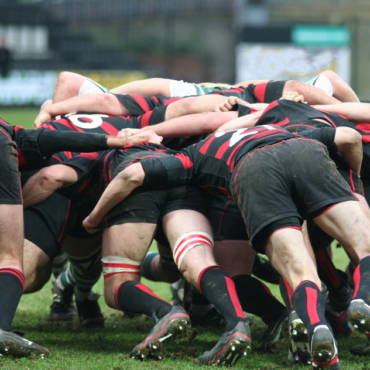Every sports coach talks about two things: writing winning training programs and developing self-confidence in their athletes. They are like time and gravity: they are the two constants throughout the (coaching) universe.
Now, there is a lot of stuff out there about training programs, writing training plans, developing periodised programs, creating killer workouts, etc. etc….a veritable mountain of information and ideas about planning, periodisation and programming in all sports.
Yet, there is surprisingly little written about how coaches can help athletes develop “real” self-confidence: by “real” I mean genuine, resilient, “bullet-proof” self-confidence: self-confidence which can withstand the pain, pressure and fatigue of preparation and performance: self-confidence which is built on real evidence and not reliant on hollow rhetoric, shallow praise and cheesy motivational sayings from guys with big teeth and nice suits.
So how do you coach Self-Confidence from an Evidence based approach?
The Critical Confidence Equation: Self Confidence = Self-Belief x Evidence
There is no doubt that self-confidence is the cornerstone of all great sporting performances.
The “Critical Confidence” equation is Self-Confidence = Self-Belief x Evidence.
The equation states that the level of self-confidence an athlete will possess is equal to their core self-belief multiplied by the evidence they have accululated from their preparation and past performances.
In other words, Self-Confidence = Who I am x What I do.
It all starts with Belief…..but you can’t change it.
The first factor in the Self-Confidence equation is Self-Belief. And, as hard as it is to accept – you can’t change it. An athlete’s core beliefs, their values, their character, i.e. who they are as a human being and how they feel about themselves etc. are pretty much established before they reach ten years of age.
It’s about their genetics, their parents, their environment, their early experiences in education settings, the opportunities they have had to learn through actual experience and problem solving….all these things shape and mould the belief systems of athletes well before they make the commitment to join a competitive sporting situation, typically in their early to mid teens.
Athletes with a strong sense of Self-Belief require very little evidence to help them create Self-Confidence, whereas athletes who lack Self-Belief require a considerable amount of time, effort and energy to help them create the Self-Confidence required to perform to the full potential in sporting competition.
Athletes with a strong sense of Self-Belief possess an innate belief that they can do anything, achieve anything and perform well in any situation, any time, any where.
Example: Athlete A: High Self-Belief Athlete, i.e. requiring little evidence to create Self-Confidence
“A player in a professional team I was working with had a remarkable senses of self-belief. He would be the first to accept any challenge presented to the team. You could almost see him thinking “I can do this” anytime something new or different was required of him. He was consistently the first player onto the field for training and the last to leave – always staying behind to do a little extra work on areas of his game which needed improvement. He would try new ideas and new things if he thought it would improve his performance. He would take a few risks here and there knowing that he could overcome any setbacks or problems they might cause. He was consistently the first into the gym for strength training and the last to leave when the team’s workout had finished. He didn’t talk about what he was going to do – he just did it. He would often do extra work or spend some extra time on his recovery or increase his commitment to analysing and improving his own game without making a “big song and dance” about it. He didn’t need the coaches or team staff to demonstrate to him all the things he was doing in preparation to boost his self-confidence – he didn’t need to be presented with evidence to help him create self-confidence – he lived excellence and clearly understood who he was and what he about”.
On the contrary, athletes with a low sense of Self-Belief, require a lot of help, support and consistent quality coaching to help them create Self-Confidence. They need to be convinced they can perform through presenting them with evidence of their preparation and prior performances.
Example: Athlete B: Low Self-Belief Athlete, i.e. requiring significant evidence to create Self-Confidence.
“An athlete I was working with was at an international level competition. In that environment as in all other previous performance situations, the athlete lacked the self-confidence to to perform to her full potential. In preparation for the competition, we sat with the athlete and presented her with “evidence”, e.g. how her training times had improved over the past year, how her test sets had demonstrated clear improvement over the past six months, how her important gym lifts had all shown a big increase in strength and power and how her performances in the past two years at national level in her own country had shown consistency and demonstrated her ability to perform when it mattered. The mountain of evidence we presented to her soon increased her confidence to the point where she could perform on the international stage successfully”.
As a coach, you can’t change Self-Belief….so let’s focus on creating Self-Confidence through Evidence…or if you like, “If I can’t change who you are, I can help you to change what you do”.
What is an evidence based approach to develop self-confidence?
Adopting an evidence based approach to developing self-confidence comes down to one thing – preparation.
In other words, as a coach, you have control over creating and maintaining the standard and quality of your athlete / team’s preparation environment. You either drive these factors through your own coaching and leadership skills or by empowering your athletes to drive these factors themselves. But either way, this is what great coaching is about: creating the environment where the opportunity for success is increased.
This is the very essence of a high performance and high performing culture: one where the standard and quality of every aspect of the preparation environment is about excellence and winning: about unparalled levels of effort, energy, enthusiasm and exceptional commitment.
Athletes and teams who thrive in such a high performance culture steadily accumulate evidence: the evidence they need to create the self-confidence to perform.
Think about your own athletes for a moment.
Imagine how they might feel standing at the starting line or running out on to the field or waiting for the gun to go knowing with absolute certainty that every aspect of their preparation – the preparation they have undertaken in the training environment and culture you have created – was uncompromisingly the best it could be in every detail.
Imagine how they might feel getting ready to race or play knowing with absolute certainty that what they have done everyday – their training, their recovery, their nutrition, their sleep management, their personal management – in their preparation environment was the best of any athlete or any team they will face in competition.
How would they feel???????
One word.
Confident.
What is “evidence” in terms of playing and competing in sport?
We often hear about sporting teams and athletes who are “on a roll”, i.e. they are winning in competition and in doing so seem to gain momentum and continue to perform well again and again.
The “Critical Confidence” equation, Self-Confidence = Self-Belief x Evidence is at work here again.
Nothing creates self-confidence like winning.
Self-Confidence comes from knowing – knowing that I can / we can “do it” on the field, in the pool, on the court, on the water, on the road, on the track etc.
When teams and athletes are winning, each winning performance becomes the strongest possible form of evidence and the self-confidence “wheel” begins to spin….more evidence leads to more self-confidence and winning performances which in turn provides more evidence which leads to increased self-confidence and more winning performances and so on and so on.
That’s why coaches strive so hard to win successive matches or events – they know, that winning creates the best form of evidence and the strongest sense of self-confidence: momentum moves mountains.
So how can coaches help to create self-confidence in athletes?
There are five key actions coaches can take to help create self-confidence in athletes – or more accurately, ways coaches can provide an environment where athletes have the opportunity to build evidence and thereby create self-confidence themselves:
1. Create opportunities for athletes to learn by doing. Evidence is what an athlete does – not what they hear, not what you say, not what they think – but what they actually do.
2. Create opportunites for athletes to learn by problem solving and overcoming adversity. Experienced coaches use problem solving as a core coaching tool. Presenting problems to solve and difficult situations to overcome teaches athletes enduring lessons and builds a strong base of evidence for athletes to call upon when self-confidence is required.
3. Set standards and attitudes high – and do not compromise on them. Once you have clearly established what “it” looks like, i.e. the preparaton environment which you believe will provide the evidence your athletes need to create strong, robust self-confidence, do not compromise on it’s delivery.
4. Teach athletes how to lead, empower them to lead and give them the responsiblity to sustain a preparation environment which consistently provides quality evidence. A preparaton environment where the standards, values and attitudes are sustained by the athletes themselves is the most powerful thing in sport. A preparation environment where the creation of self-confidence is inevitable because the consistent quality of the evidence is overwhelmingly strong is the goal of every coach who wants to win.
5. Re-set the bar often – including your own – success is a moving target. Continually shift standards and attitudes higher – strive to ensure your own learning, development and commitment is greater than that of your athletes. Let your own coaching be the single strongest piece of evidence in your program.
Summary:
- Self-Confidence is the currency of sports performance: the more you have to “spend”, the better the performance can be.
- And like any other currency, self-confidence needs to be earned through hard work, saved and then spent when and where it can have the biggest impact.
- For any athlete this means earning self-confidence through an uncompromising commitment to every aspect of preparation and it doing so saving a stockpile of evidence that grows over time to give them the power to “purchase” any performance. The “more expensive” the performance, (i.e. the higher the level), the more confidence required, the more evidence you need to save – i.e. the higher the level of performance, the harder and more consistently you have to work.
Start saving today….and invest in yourself and in your next performance.
Wayne Goldsmith
This post and all the content on this blog are copyright Wayne Goldsmith and may not be used in part or in whole without the expressed consent of the author.



